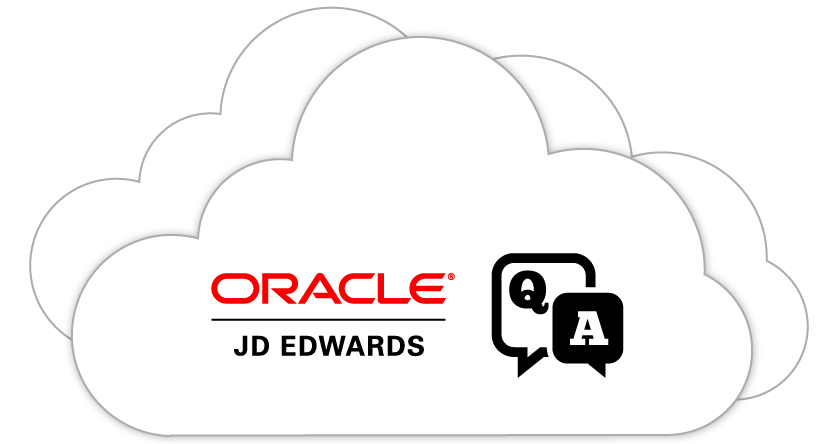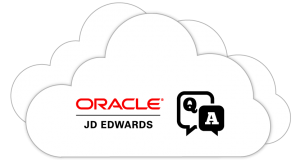
 When thinking about using a cloud application, changing solely to a SaaS application is not the only option. Lift and shift your current on-premise JD Edwards solution to cloud infrastructure and realize the same benefits. Below is a comprehensive list of Frequently Asked Questions about JD Edwards in the cloud.
When thinking about using a cloud application, changing solely to a SaaS application is not the only option. Lift and shift your current on-premise JD Edwards solution to cloud infrastructure and realize the same benefits. Below is a comprehensive list of Frequently Asked Questions about JD Edwards in the cloud.
Q: What has Oracle announced about JD Edwards and Oracle Cloud?
A: Oracle has announced the availability of two JD Edwards EnterpriseOne offerings on the Oracle Cloud Marketplace. The first is the JD Edwards EnterpriseOne Trial Edition, an “all-in-one” image of a JD Edwards EnterpriseOne system, which makes it easy and fast to deploy. Built with current Applications and Tools releases, it is a great way to explore the latest features. The second is a Multi-Tier Edition, which includes discrete images for the enterprise server, HTML server, and database server. This edition also includes Server Manager, enabling a system administrator to have more control over the deployment configuration. The Multi-Tier Edition also includes utilities for moving customers’ data and custom objects from on-premise to the cloud environment. Using the Trial Edition and the Multi-Tier Edition, JD Edwards customers can get a hands-on experience of running JD Edwards EnterpriseOne on Oracle Cloud.
Q: What is Oracle JD Edwards EnterpriseOne on Oracle Cloud?
A: This refers to running Oracle JD Edwards EnterpriseOne on Oracle’s Cloud Infrastructure as a Service (IaaS) and Platform as a Service (PaaS) offerings, specifically the Oracle Compute Cloud Service and the Oracle Database Cloud Service.
Q: What capabilities are currently provided?
A: With an Oracle Compute Cloud subscription and with the tools provided in the Oracle Cloud Marketplace, you can quickly provision new instances of Oracle JD Edwards EnterpriseOne, deploy development tools on the cloud, as well as clone your existing Oracle JD Edwards EnterpriseOne instances from on-premises to Oracle Cloud. In addition, your on-premises and cloud instances can be managed simultaneously from the Oracle Application Management Suite.
Q: What are the key benefits of using Oracle JD Edwards EnterpriseOne on Oracle Cloud?
A: Key benefits are support for business growth, greater business agility, and lower costs and risks. Organizations must be agile to respond to changes such as acquisitions, globalization, divestitures, and regulatory or process changes, with the ability to adopt new technologies or applications functionality. IT can provision new development and test environments quickly in response to such changes while ensuring continuity of day-to-day operations. Oracle’s IaaS is elastic and allows IT to scale up or scale out the infrastructure on demand. This elasticity and the flexibility to pay-as-you-go reduce the need for upfront capital expenditure and decrease wait times for hardware and other resources, reducing overall project risk. Oracle Cloud provides a complete integrated cloud platform with best-in-class IaaS and PaaS suite offerings, which allows for hybrid deployment choices across private and public cloud options.
Q: Is Oracle releasing JD Edwards EnterpriseOne as a Software as a Service (SaaS) application?
A: No, Oracle has no plans to offer JD Edwards EnterpriseOne as a SaaS solution.
Q: Does Oracle provide managed services for JD Edwards EnterpriseOne on Oracle Cloud?
A: Yes. Oracle’s Managed Cloud Services (OMCS) team provides managed services for customers running Oracle JD Edwards EnterpriseOne instances on Oracle Cloud or on-premises. Oracle partners can also provide managed services with JD Edwards on Oracle Public Cloud.
Q: Are there additional fees for using JD Edwards EnterpriseOne with Oracle Cloud?
A: Oracle Cloud resources and services are available for subscription by Oracle customers. Oracle customers who already own a license to JD Edwards EnterpriseOne applications may use Oracle Cloud to host instances of their licensed applications. Oracle’s Compute Cloud uses a “Bring your Own License” model, so customers who want to use Oracle Compute Cloud must already own a valid license to the software deployed on virtual machines in Oracle Compute Cloud. Oracle Cloud is a subscription priced offering in addition to your JD Edwards license and support payments.
Q: What are some of the ways I can use JD Edwards EnterpriseOne with Oracle Cloud?
A: JD Edwards EnterpriseOne continues to lower the total cost of ownership (TCO) with simple provisioning of JD Edwards EnterpriseOne in Oracle IaaS. The JD Edwards EnterpriseOne Trial Edition all-in-one image with demo data enables customers to explore new functionality in JD Edwards EnterpriseOne Application Release 9.2, such as new industry modules, One View Financial Statements, Internet of Things Orchestrator, as well as mobile and user experience, without installing JD Edwards EnterpriseOne in their data centers. Alternatively, customers on JD Edwards EnterpriseOne Application Release 9.1 can easily provision multi-tier environments in Oracle IaaS. This solution in combination with the Server Manager component and the Migration Toolkit provided by Oracle allows customers to easily move their development and test data, customizations, and patch level from their on-premise instances to Oracle IaaS. In addition, customers can leverage Oracle Database Cloud Service (DBCS) for the JD Edwards database layer. The combination of IaaS and DBCS enables customers to quickly provision new instances of JD Edwards EnterpriseOne, resulting in reduced administration cost and increased agility.
Q: How do I deploy Oracle JD Edwards EnterpriseOne on Oracle Cloud?
A: Once you have an Oracle Compute Cloud subscription, you can access the Oracle Cloud Marketplace. Select JD Edwards from the Marketplace list of application images. Deploy the ready-made machine images for provisioning, cloning, and development using the processes described in our online tutorials. Current deployment options supported include a Trial Edition, Multi-Tier Edition, and Multi-Tier with DBCS.
Q: Can I do customizations on JD Edwards EnterpriseOne when I use Oracle Cloud?
A: Yes, the JD Edwards EnterpriseOne software architecture allows for customers to modify or customize their systems, whether the systems are deployed on Oracle Cloud or within an on-premise data center.
Q: How do I migrate JD Edwards EnterpriseOne customizations and data from my on-premises production system to the cloud?
A: A cloud migration utility is available that enables this migration.
Q: Can I upgrade my JD Edwards EnterpriseOne instance as part of migrating to the cloud?
A: No. The cloud migration utility currently only allows for the same EnterpriseOne release migration from on-premise to the cloud.
Q: Is it possible to migrate my JD Edwards EnterpriseOne test instances currently running on a non-Linux platform to Oracle Cloud?
A: Oracle Cloud runs Oracle Linux. You must first migrate non-Linux instances (such as Solaris, AIX, HP-UX, and Windows) to Linux on-premises, and then use the procedure outlined in the tutorial Migrating to a JD Edwards EnterpriseOne Multi-Tier Deployment on Oracle Compute Cloud Instances.
Q: Is there any difference in the patching of the apps, database, and middleware in the cloud versus on-premises?
A: The same tools and utilities are used to patch components in Oracle Cloud and on-premises. You can use Server Manager to update the Tools Release and Deployment Server instance provided in Cloud to update your JD Edwards EnterpriseOne Apps.
Q: Can I use the same certified third-party products I currently use on-premise with JD Edwards EnterpriseOne on Oracle Cloud?
A: Yes, the entire JD Edwards EnterpriseOne architecture is the same, whether deployed on-premise or on Oracle Cloud. All the third-party components that comprise a JD Edwards EnterpriseOne application instance will be deployed in the cloud. Oracle’s Cloud strategy should also allow customers to use Oracle Cloud to host instances of other applications that may be used to integrate with their JD Edwards EnterpriseOne systems. See the published capabilities and guidelines for using Oracle Cloud with your non-Oracle workloads.
Q: What tools are used for managing JD Edwards environments on Oracle Cloud?
A: The Oracle Application Management Suite enables you to monitor and manage Oracle Cloud and on-premises instances with a unified interface.
Q: Will my cloud-based JD Edwards system be visible to the general public?
A: No, based on Oracle Compute Cloud’s default security settings, your JD Edwards instance will only be accessible by your internal users and teams.
Q: Can I use the Database Cloud Service and Exadata Cloud Service with Oracle JD Edwards EnterpriseOne?
A: Oracle JD Edwards EnterpriseOne Development is currently testing various deployment configurations with the database hosted on the Oracle Database Cloud Service and the application tier hosted on the Oracle Compute Cloud Service. To meet any immediate requirements, you may want to engage Oracle Cloud Managed Services, Oracle Consulting, or an Oracle partner.
Q: Does Oracle support deploying production instances of Oracle JD Edwards EnterpriseOne on the Oracle Compute Cloud Service?
A: Yes, Oracle supports deploying production instances of Oracle JD Edwards EnterpriseOne on the Oracle Compute Cloud Service. To facilitate such deployments, Oracle JD Edwards EnterpriseOne Development is currently testing various complex system configurations, developing additional automation options, and devising best practices. To meet any immediate requirements, you may want to engage Oracle Managed Cloud Services, Oracle Consulting, or an Oracle partner to evaluate your needs and help transition your production workloads to Oracle Cloud. Oracle advises customers and partners to undergo the same discipline of planning, deploying, and testing the functionality and performance of a JD Edwards EnterpriseOne system on Oracle Cloud as they would for an on-premise or hosted deployment.
Q: What does hybrid cloud mean for JD Edwards EnterpriseOne?
A: As customers and partners evaluate their choice of platform and deployment options for their JD Edwards EnterpriseOne installations, one of the most common configurations that might make business sense will be a hybrid deployment model. Depending on the business needs, the development and test environments can be deployed on the cloud platform while the production instance will continue to be run on-premise. The EnterpriseOne instance can be deployed on the cloud platform while some of the integrations will run on-premise or vice versa. JD Edwards cloud platform strategy supports these scenarios and allows for a hybrid deployment model, based on the choice and control of our customers and partners.
Denovo understands the cloud. We provide comprehensive services to help your business accelerate growth. We also partner with companies to scale the capabilities of the cloud as your business expands.
Our Safe Passage methodology helps companies to smoothly migrate to the cloud. This four-phase program takes a deliberate approach to data migration, data security, disaster recovery, and 24x7x365 production environments. To learn more about how Denovo can supply your cloud needs, schedule a free consultation.
